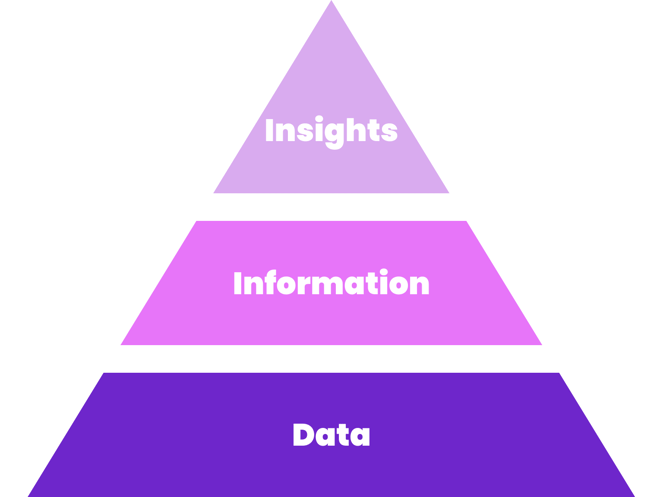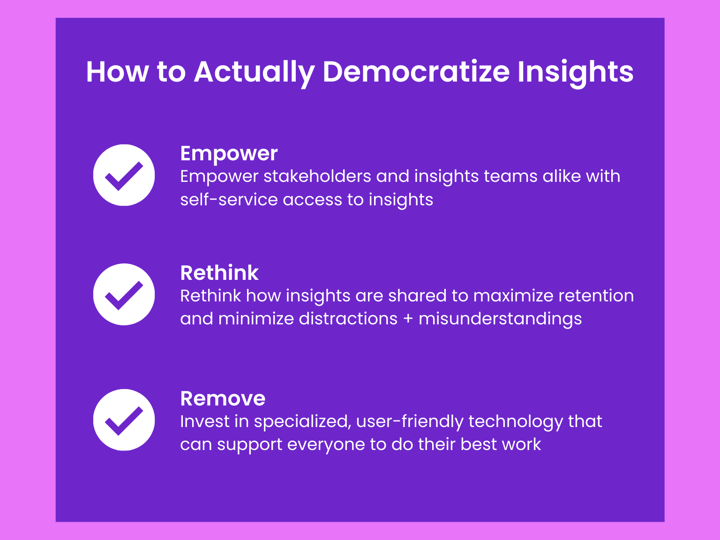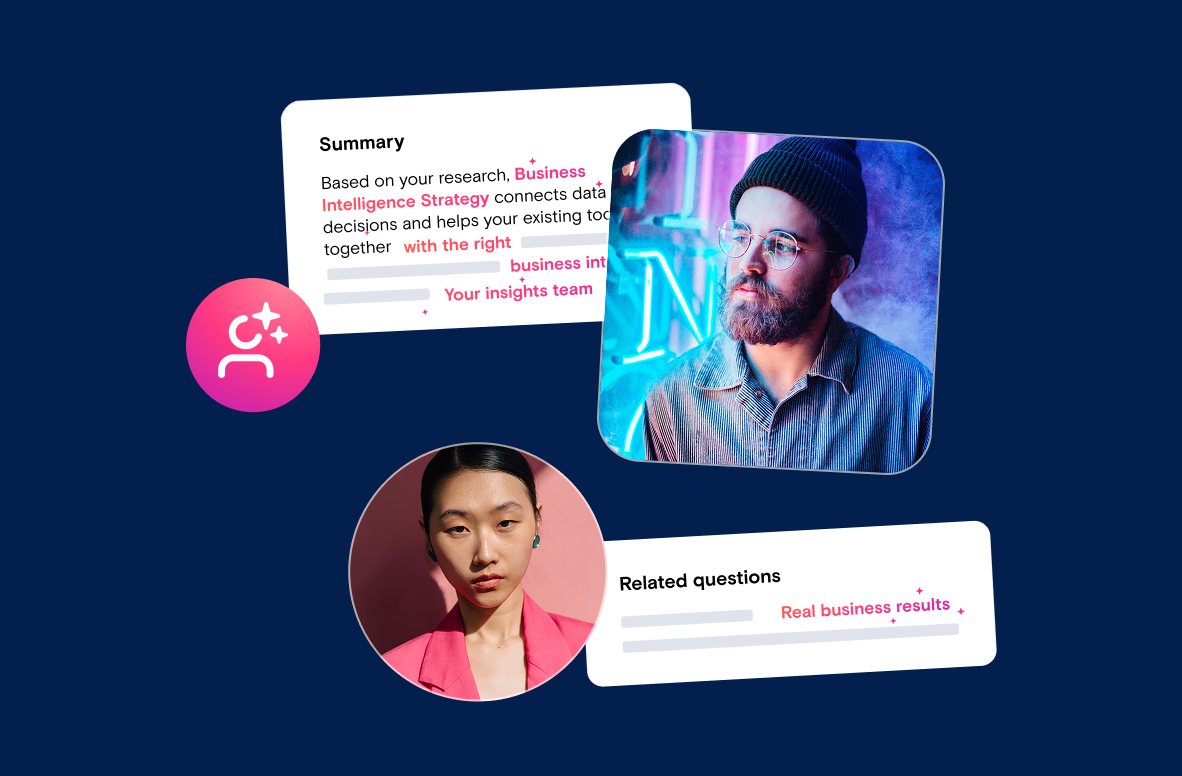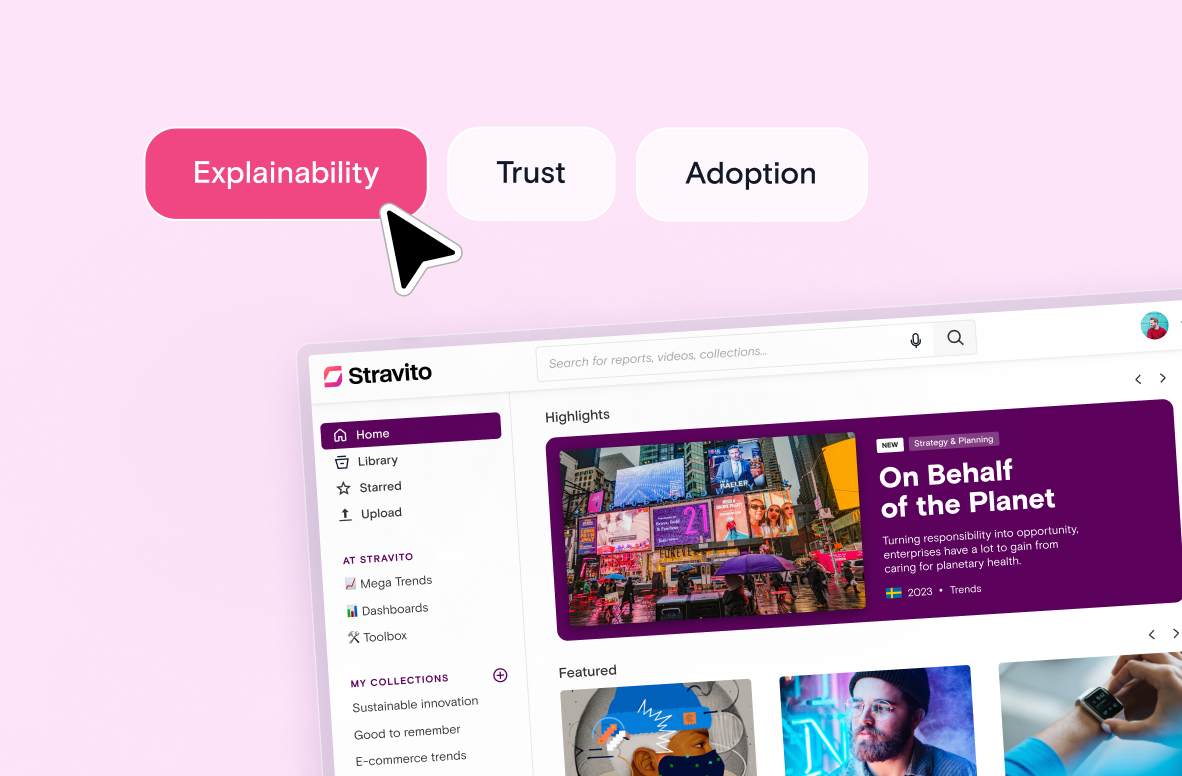Democratizing insights means to make insights accessible to stakeholders across the organization. However, making insights accessible isn’t as straightforward as it might sound.
That’s because democratizing insights isn’t just a matter of distributing insights. Rather, it’s a matter of empowering stakeholders to access, process, and apply insights in a way that can be sustained over the long term.
In this article, we’ll dig deeper into what it really means to democratize insights by:
- Differentiating between similar terms
- Exploring why it’s so important to democratize insights
- Illustrating the concrete steps involved in making it happen
What’s the difference between democratizing data, information, and insights?
While these terms are often used interchangeably, they actually indicate subtle but important differences about what is being made accessible.
Data
Data refers to the cold, hard facts. This often means the numbers themselves, such as survey results or sales figures.
Information
Information is when that data starts to develop into a story. For example, this might mean additional context or patterns that start to give the raw numbers meaning.
Insights
Insights are the actionable conclusions from that story. They tend to be what are most valuable to organizational stakeholders beyond the insights or data functions.
Because insights are the most directly applicable, it makes sense to prioritize their democratization over that of data or information. This helps to increase the likelihood that insights are applied in decision-making processes, which is the desired outcome.

Why is it important to democratize insights?
The short answer: Consumer centricity.
Consumer centricity refers to the practice of making business decisions centered around the needs and wants of all consumers who could potentially purchase your product. It’s a business philosophy that focuses on why consumers are or aren’t buying your product, respecting the ephemeral identity of the customer for consumer-facing businesses. And as research has shown, it’s vital for business success.
In order to ensure that consumers stay at the heart of all decisions, it’s essential that stakeholders across the organization always have them top of mind. But knowledge silos and bottlenecks can create workflow inefficiencies that get in the way of this.
For example, if stakeholders have to go to the insights team for every single question or request, the insights team will likely be overloaded with requests, especially in a large organization. This frequently leads to the bulk of the insights team’s time being spent on answering requests, many of which are repetitive.
This not only increases the time between a stakeholder asking a question and receiving an answer, but it also drastically reduces the amount of time that insights teams are able to put into high-value tasks like forecasting, trendspotting, and analysis.
The result is that no one is able to do their job as they would like to. Decisions have to be made, and if insights aren’t made available at the right stages of a project, they risk being forgotten or not applied at all.
When done right, democratizing insights can increase efficiency, and it also allows for individuals across the organization to leverage their unique expertise.
How does democratizing insights impact insights teams?
Before we go any further, it’s essential to highlight a common misconception about insights democratization: that it will make insights teams irrelevant. If everyone can access the insights they're looking for, where does that leave the insights team members?
The fact of the matter is that insights teams are frequently undervalued. In fact, one study found that as many as 80% of companies limit the role of the Consumer Insights function, instead of viewing them as a strategic business partner or a source of competitive advantage. They end up functioning as librarians or an information desk for stakeholders in the organization, answering requests for information or being asked to commission research on specific topics.
This also tends to coincide with insights teams being included only sporadically throughout the stages of projects, helping to affirm decisions that have already been made, rather than being given the opportunity to apply their expertise in a deeper, more meaningful, and more proactive way.
Because consumer behavior is complicated. Treating insights teams as a strategic business partner ensures that the complexity of human behavior is taken into account when interpreting consumer research.The true expertise of insights teams lies in carefully analyzing data through a critical yet holistic lens, in order to offer nuanced and actionable interpretations to stakeholders.
Thus, elevating the role of insights teams is crucial for practicing consumer centricity because it ensures that it’s actually insights, not just data or information that are being distributed throughout the organization.
How to actually democratize insights
While exact steps will always depend on your organization’s specific needs, there are 3 core capabilities involved in democratizing insights: self-service access, thoughtful knowledge sharing, and minimized barriers to long-term success.
1. Empower with self-service access
One of the best ways to empower stakeholders is to ensure that they have self-service access to vetted insights. If they come up with a question or their curiosity is piqued, they should be able to get a quick answer themselves, especially if it’s regarding a key topic or trend.
Sometimes, of course, a question will still require the expertise of insights managers. Whether that’s clarifying the nuances of a specific finding or commissioning new research to answer a previously unexamined question, it’s essential that insights managers themselves can also quickly access the information they need.
By reducing the volume of requests for information that have to go directly through the insights team, stakeholders will be able to apply more insights in a timely manner, and insights managers will have increased capacity to work as a strategic business partner, rather than an information desk.
2. Rethink how insights are shared
Access, however, is just one part of the equation. Research reports need to be packaged and delivered in a way that makes them easy to digest. Otherwise, insights might be accessed but still go unused; having access to information doesn’t mean that we will retain it.
In fact, the German psychologist Hermann Ebbinghaus found that if new information isn’t applied, we’ll forget about 56% of it after just 1 hour.
When it comes to packaging insights, it’s particularly important that key details, like conclusions and sample demographics, can be understood with ease. Otherwise, insights could be misinterpreted or misapplied.
It’s also essential to be thoughtful about how insights are shared. Democratizing insights is, at its core, a form of organizational learning. This means that there needs to be an ongoing flow of information, instead of just relying on one-off questions from stakeholders.
But again, in order to make sure that insights are processed effectively, it’s important to consider the timing of delivery. Embracing asynchronous communication can help stakeholders and insights managers alike digest insights at a time that works best for them.
3. Remove obstacles that prevent long-term success
As with any organizational initiative, there will always be numerous obstacles that can hinder long-term success. Getting the necessary buy-in, securing budget, and navigating shifting business priorities can prove challenging even under near-perfect conditions.
An obstacle that is easy to address is the amount of additional work this sort of initiative can create. With calendars already packed and to-do lists overflowing, it’s smart to look for a solution that will minimize extra work related to implementation and maintenance.
Choosing the right technology to help you to democratize your insights allows you to control for certain predictable challenges. A dedicated insights platform can make all the difference.
Capabilities like AI-powered search, user-friendly design, and experienced implementation support can help to ensure that your initiative is a success. Of course, the most benefits are reaped when all 3 of these factors are present, and the solution set-up is tailored to your organization.
Summary
Democratizing insights is different from democratizing data or information because it results in the distribution of actionable conclusions.
For insights teams, democratizing insights allows them to focus on more proactive and meaningful insights work.
By ensuring that stakeholders across the value chain have self-service access to quality, vetted insights, consumer needs can be more easily incorporated into all levels of decision-making.
With the right mindset and the right technology, democratizing insights can go from vision to reality.



.png?width=1200&name=2021%20Blog%20CTAs%20(7).png)


